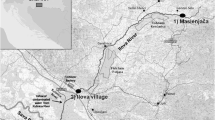Abstract
The cutting operations of dimension stone at quarries produce a large amount of fines that, in turn, cause a negative environmental impact over local surface waters. This article presents a detailed analysis of the mobilized contamination associated with runoff waters in a large granite quarry (∼200 ha) which is located in Porriño (Galicia, NW Spain), the most important production centre of dimension stone in Spain. There, an intensive monitoring survey was developed in order to characterize the hydrology of the system as well as the release and transport of pollutants. This was accomplished by means of different control sections for the flow and by the collection of 52 random water samples. Automatic samplers were also used to collect 192 water samples associated with runoff generated by significant rain events. For each of the samples collected, a wide battery of analytic determinations was performed, including solid loads, turbidity, organic pollution, nutrient and selected metals. Upon careful examination it has been possible to obtain different parameters related to the contamination control, like the “event mean concentration” (EMC), maximum concentrations and specific sediment loads. Moreover, a comprehensive statistical study including parameter correlation and cumulative probability analyses helped to understand the pollutant mobilization behaviour within the quarry system. It can be concluded that mobilized contamination shows the anomalous presence of some metals, whose concentrations are in excess when compared to the natural rock. This excess metal amount must be attributed to an anthropogenic source associated to mining and cutting operations.










Similar content being viewed by others
References
American Public Health Association (APHA), American Water Works Association (AWWA) and Water Pollution Control (WPCF) (1992) Standard methods for the examination of water and wastewater, 18th edn. American Public Health Association, Washington
Butler D, Davies JW (2000) Urban Drainage. E&FN Spon, New York, 489 pp
Sánchez N, Rodríguez-Reya A, Suárez LM, Díez I, Calleja L, Ruíz de Argandoña VG (2005) The influence of rock microhardness on the sawability of Pink Porrino granite (Spain). Int J Rock Mech Min Sci 42:161–166
Sansalone JJ, Cristina CM (2004) First flush concepts for suspended and dissolved solids in small impervious watersheds. J Environ Eng 130:1301–1315
Author information
Authors and Affiliations
Corresponding author
Rights and permissions
About this article
Cite this article
Peña González, E., Suárez López, J., Delgado Martín, J. et al. Analysis of the mobilization of solid loads and heavy metals in runoff waters from granite quarries. Environ Geol 50, 823–834 (2006). https://doi.org/10.1007/s00254-006-0254-9
Received:
Accepted:
Published:
Issue Date:
DOI: https://doi.org/10.1007/s00254-006-0254-9




